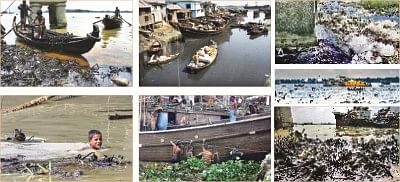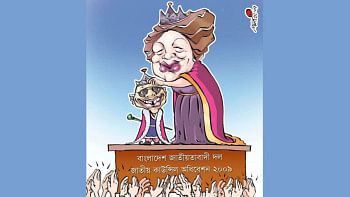Karnaphuli prey to environmental degradation

The varied colours of Karnaphuli river, a stark reminder that toxic waste is eating it away, slowly diminishing its grandeur and ability to sustain aquatic life. Photo: Anurup Kanti Das
Relentless dumping of highly toxic liquid and solid wastes is slowly choking the river Karnaphuli, the lifeline of country's economy.
The scientists in a recent research on the Karnaphuli found traces of radioactivity 'very close to risk level' on the soil.
They warned that the soil along the river's shores and on the riverbed is likely to be highly contaminated due to unabated dumping of highly hazardous industrial wastes.
The scientists in their research tried to find out risk level of radioactivity of the chemicals of the river soil. Kowsar Alam, a teacher of Chittagong Veterinary and Animal Sciences University (CVASU) who conducted the research, said according to the United Nations Scientific Committee on the Effects of Atomic Radiation on 2000 (UNSCER), normal level of radiation hazard due to radioactivity is 0.5.
The scientists in their research got 0.6507 for external radiation hazard and 0.82 for internal radiation hazard where the risk level is 1.
Manjurul Kibria, professor of Chittagong University Zoology Department, said if radioactivity of the river soil goes up it will hamper the natural breeding of fish as well as growth of fishes. About the affect of radioactivity on fish, he said if the people eat the affected fish it may spread to their body.
The water of the Karnaphuli has already lost quality as well as biodiversity of the river is being damaged rapidly while the Department of Environment (DoE) and Chittagong City Corporation (CCC) have failed to take initiatives to reduce the pollution.
The experts said the riverside factories, human wastages, oil spilling by boats and vessels are responsible for the pollution. The local people have abandoned the use of water for household activities due to pollution. The experts said ratio of the pollution in the city is higher than that of the remote area.
Idris Ali, professor of Chittagong College who has been working on pollution of the Karnaphuli for two decades, said DoE and the city corporation have failed to save the river from pollution as about 300 factories on the river bank are discharging wastes into the river. Of the factories, only two to three have effluent treatment plants (ETP), Idris added.
Prof Idris said the reputed factories like Karnaphuli Paper Mills, Chittagong Urea Fertilizer Limited (CUFL) and KAFCO have no ETP to treat wastes.
“CCC fails to stop the discharging human wastages into the river while sewage is carried to the river, decreasing the life of river”, Idris added.
DoE, Chittagong Director Jafar Alam admitted about the bad condition of the river, saying that according to a High Court order they asked the factories to set up ETPs.
There is also difference between DoE's report and local researchers' report on pollution.
Jafar said they found the quantity of dissolved oxygen (DO) was about 5.3 milligram per litre (mg/L)- 5.6 mg/L against the standard level 7 mg/L-10 mg/L while Prof Idris said they found 3.00 mg/L- 4.50 mg/L.
It is harmful for all living beings when the figure of DO decreases.
Prof Idris said DoE always collected the sample water from far away from river bank to prove it as normal pollution while he collected samples from river bank to get the real condition about the pollution.
DoE Director Munir Chowdhury said the industries without ETPs on the river bank were responsible for pollution.
Mayor M Manjur Alam said they asked the city dwellers not to discharge their wastages in the canal as well as river. Manjur said it is duty of DoE not CCC to look after the ETPs.
When contacted, State Minister for Environment and Forest ministry Hasan Mahmood declined to make any comment over phone on November 9 in this regard as he was in Dhaka.
When visiting the river bank areas like Chaktai Khaler Mukh, Monohar Khal, Sadarghat, it was found that people are reluctant to use the river water.
Khorshed Alam, a resident of Avoy Mitro Ghat who has been living in the area for 35 years, said once the local people used to catch fish in the river regularly which is no more seen today due to pollution. Number of fish has also decreased, Khorshed added.
Amzad Mia, a businessman of Fishery Ghat, said different kinds of fish were available in the river 15 to 20 years ago, but now most of them have disappeared.
Experts said the areas adjoining the city are polluted more than that of the village side. They blamed different factories on the river bank without the Effluents Treatment Plants (ETPs) and have been discharging the waste water and rubbish into the river.
It was found that the river bank areas have been dumped by polythene products and industrial and household wastes.
Local people alleged that the canals flowing through the city have been carrying wastages from different areas to the river.
They said along with different kind of wastages the Chaktai Khal has been driving out 70 percent of the liquid waste of city to the Karnaphuli. They said through the canal a stream of black water is also flowing to the river.
Besides, oil spill from boats and vessels and washing boats in the river are also responsible for pollution. Local people alleged that the boats anchored at different canal mouths spill the oil from the tank during cleaning.

 For all latest news, follow The Daily Star's Google News channel.
For all latest news, follow The Daily Star's Google News channel. 



Comments